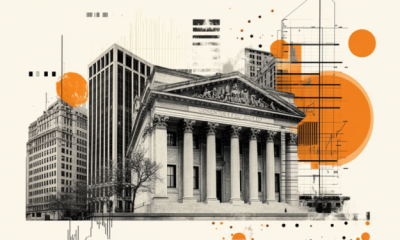

others
Why Europe’s DORA regulation is a band aid but not a cure – Crypto News
Whenever there’s a global financial calamity, whether it’s on the horizon or if it has already happened, you can expect to see a flurry of regulation to stem the flow of disruption. Even as far back as the 1720’s, Britain enacted the bubble act, to regulate the stock market after the South Sea Company’s stock bubble burst amid accusations of insider trading and to cool down inflated markets. The Great Depression spawned the emergency banking act of 1933 in the United States, and the 2008 credit crunch precipitated Dodd-Frank in the US, and in Europe, MiFID and ESM, There’s no end in sight for regulators because just as the ink is drying on one piece of legislation, another event or innovation emerges that requires attention.
Regulators will always be on the hamster wheel of change, never quite getting to the point where they can claim victory over errant markets, and perhaps the next decade will see their toughest challenges yet. While they are still finessing traditional market reforms, they now have to ensure that users of the expanding Web3 ecosystem — defined by blockchain, decentralized finance (DeFi) and centralized finance (CeFi) platforms, including digital assets — are protected from being exploited by criminals and other bad actors.
DORA’s broad reach
The European Council’s recent approval of the Digital Operational Resilience Act (DORA) is the latest addition to the raft of regulations that are currently in the pipeline. DORA aims to consolidate and harmonize essential cybersecurity requirements regarding digital resilience in the financial sector. Under DORA, there are 21 types of financial institutions in its scope, including large enterprises like banks, insurance companies and pension funds as well as smaller digital e-money providers, token issuers and crypto asset providers.
The DORA regulation is part of a broader European package of policy measures for fintech that includes proposed regulation on crypto-asset markets (MICA) and one on distributed ledger technology (DLT). In view of the recent FTX fallout, it comes at an opportune time as the knock-on effect of the collapse is precisely what this legislation is aiming to mitigate. In its essence, DORA aims to ensure that firms can cope with cyberattacks and operational disruptions by implementing governance, cybersecurity, and ICT risk management and incident-reporting measures.
More legislation on the way
DORA and MiCA are not the only pieces of legislation that are coming on line. we have the digital financial assets (DFA) consultation papers being drafted independently by the US and the UK, the Digital Markets Act (DMA), which is more focused on internet businesses, the Digital Governance Act (DGA), which creates a framework for increased data availability and re-use within the European Union, and AI Reg, the regulatory proposal that aims to provide developers, deployers and users with clear requirements and obligations regarding uses of artificial intelligence. All of these regulatory initiatives have fundamental game-changing capabilities, and the aim is to have them solidly in place by 2030. This date, however, feels a little pessimistic, as the rapid rate of innovation is likely to render this deadline moot.
As with all regulatory processes, DORA has gone through many drafts, and its recent approval has been welcomed by all players in the industry. Cyberthreats have been growing with alarming intensity over the last decade, and the impact this has on global economies, as well as organizations and individuals, is massive. While Gartner predicts organizations will spend nearly US$6.69 billion on cloud security in 2023, rising almost 27% year-over-year, the Web3 industry is still not doing its part in tackling the potential US$10 trillion cyber-damage problem that we could face by 2025. While DORA is a great foundation, the proposed regulations are somewhat ambiguous and by no means complete. For example, it does not mandate how much companies should aim to spend on cybersecurity, and there is a lack of clarity on what methods should be employed in order to achieve a higher capability of threat mitigation.
Plugging the holes
The biggest issues requiring attention include the proliferation of remote devices, the internet of things (IoT), remote working, social networks, and cloud servers — all of which can act as single points of failure within a security system. In the past, companies could ringfence their cybersecurity within the confines of the organization, but these borders no longer exist, and firms are vulnerable to attack from literally thousands of access points.
DORA will now hold companies accountable for breaches caused by weak security, so there will be a big scramble to mitigate these threats. However, if organizations are going to beat cybercriminals at their own game, using old technology will simply not work. Companies will need to change the game, and this means an entirely different approach to technology.
Unfortunately, DORA doesn’t go far enough to incentivize companies to adopt new leading-edge technology. The legislation is firmly seated in traditional and centralized cyber security solutions, which have been proven to be ineffective in protecting Web2 and Web3 ecosystems. The central argument against current cybersecurity solutions is that not only are they woefully outdated, with some technology being 40 years old, traditional cybersecurity solutions have not been designed to integrate with Web3. In essence, companies are using centralized technology to mitigate the risk in decentralized markets.
Decentralized cybersecurity mesh
,Cyber security mesh— a holistic approach to improving cybersecurity for organizations — has recently been championed by Gartner as a recent trend. However, we need to flip the narrative to decentralized cyber security mesh, which protects devices in real time from cyber threats while enforcing cyber security standards across networks. Decentralized cybersecurity tech companies should focus on “fit for purpose” cybersecurity solutions that facilitate more robust cybercrime prevention tactics. They could create real-time, zero-knowledge proofs of the cyber status of all devices, networks and environments, by utilizing Swarm AI and blockchain technology. The advantage of this approach is that they would be able to prove to auditors and businesses the state of security at a specific point in time. The solution could also be useful for courts to help them analyze forensics data.
The biggest threat—people
There is a risk that the regulation will create a tick-box culture among companies that claim that they are compliant but fail to address the biggest issue — the lack of integration of a cybersecurity mindset amongst all its employees. Leaving it up to the IT team to defend a company’s borders means that the most significant point of failure is overlooked. It is estimated that over 90% of all security breaches come from individuals within an organization. So cybersecurity is not just about the technology, it is about arming individuals with the mindset and tools to act as part of the defense.
Enforcement needs resources
When rules are put in place they need to be enforced. In order to do this you need a large network of skilled individuals who can monitor and evaluate non-compliant entities, and they must have the supporting infrastructure to be able to enforce the rules. The sheer volume of organizations that are affected by this legislation, coupled with complex global networks that often underpin Web2 and Web3 organisations, will pose a human resource challenge for the regulator.
The only sustainable solution is a blend of self-regulation that uses automation, blockchain and external regulations, where all stakeholders participate in monitoring the industry. This is not an unworkable situation because every party will benefit from a safer cyber-threat-free landscape.
Increasing trust
Another key issue that needs to be addressed in the cybersecurity ecosystem is to ensure that the data being fed into systems from multiple sources is known and trusted. Currently, processes that generate data are not trusted. Decentralized cybersecurity leverages these single points of failure by turning them into nodes for distributed validation. This then creates exponential resilience for digital operations, compared to local or internal validations — ie, no single bad actor can tamper with the settings or code. This eradicates the vulnerability in a network.
This is where a blockchain-based, decentralized cybersecurity mesh really comes into its own because it allows us to for the first time trust the validation process itself. It also unifies every device at the cybersecurity and governance level. It negates the single point of failure vulnerabilities that are inherent in centralized cybersecurity systems today. In addition, it creates an intelligent trust network by using Swarm AI, that detects behavioral changes and vulnerabilities in near real-time, potentially before hackers can infect and take over the entire network.
This is what DORA is all about. It’s all about maintaining truth and trust and negating single points of failure within untrusted environments. Until we use decentralized cybersecurity to address Web3 vulnerabilities, we will continue to see the same high levels of cybercrime currently plaguing blockchain and discouraging cryptocurrency mass adoption.
-

 Metaverse1 week ago
Metaverse1 week agoWhat Satya Nadella’s latest shakeup says about Microsoft’s evolving AI strategy – Crypto News
-

 Metaverse1 week ago
Metaverse1 week agoWhat Satya Nadella’s latest shakeup says about Microsoft’s evolving AI strategy – Crypto News
-

 Technology1 week ago
Technology1 week agoAI isn’t the dot-com bubble, but that won’t stop it from ending badly – Crypto News
-
Technology1 week ago
STON.fi CMO on Building TON’s Largest Swap & Liquidity Aggregator – Crypto News
-
Technology1 week ago
Breaking: China Renaissance Bank Eyes $600M Raise for BNB-Focused Fund with YZI Labs – Crypto News
-

 others7 days ago
others7 days agoChina’s Commerce Ministry urges US to correct its wrong practices as soon as possible – Crypto News
-

 Cryptocurrency5 days ago
Cryptocurrency5 days agoStripe’s stablecoin biz seeks national bank trust charter – Crypto News
-

 Technology1 week ago
Technology1 week agoChatGPT will soon pay for you! India’s AI payment pilot set to go live: What it means for users – Crypto News
-

 Blockchain1 week ago
Blockchain1 week agoCrypto Traders Show ‘Rationalization’ Behavior’ After Market Plunge – Crypto News
-

 Cryptocurrency1 week ago
Cryptocurrency1 week agoWhy Bitcoin could rebound up to 21% this week: experts explain – Crypto News
-

 Technology1 week ago
Technology1 week agoBest phones under ₹15,000: Oppo K13 5G, Infinix Note 50s, iQOO Z10x and more – Crypto News
-

 Metaverse1 week ago
Metaverse1 week agohuman intelligence for artificial minds – Crypto News
-

 others1 week ago
others1 week agoTrump’s tariff threat pushes US Dollar below 99 amid trade tensions – Crypto News
-

 Cryptocurrency1 week ago
Cryptocurrency1 week agoShiba Inu Burn Rate Crashes 99% as Crypto Sees Largest Liquidation Event Ever – Crypto News
-

 others1 week ago
others1 week agoEUR/JPY retreats as Euro slides on French political uncertainty – Crypto News
-
others1 week ago
Binance Founder CZ Addresses BNB’s Recent Strong Price Performance, Says It Has No Market Makers – Crypto News
-

 others1 week ago
others1 week agoWhich way out of the range – Crypto News
-

 Metaverse6 days ago
Metaverse6 days agoWalmart teams with OpenAI for ChatGPT purchases. The retailer is ‘ahead of the curve’. – Crypto News
-
Technology1 week ago
Tom Lee’s Fundstrat Predicts Ethereum Rally to $5,500 Following ETH ‘Bottom’ – Crypto News
-
others1 week ago
Peter Brandt Flips Bullish on Bitcoin, Ethereum, XRP, and XLM – Crypto News
-

 Cryptocurrency1 week ago
Cryptocurrency1 week agoThe Latest Nobel Peace Prize Winner Is a Bitcoin Supporter – Crypto News
-

 others1 week ago
others1 week agoA balanced approach to monetary policy only works if inflation expectations are anchored – Crypto News
-

 De-fi1 week ago
De-fi1 week agoDeFi Withstands Stress Test as Market Mayhem Wipes Out Nearly $20B – Crypto News
-

 Metaverse1 week ago
Metaverse1 week agoIndia key to shaping future of Artificial Intelligence, says Anthropic CEO Dario Amodei after meeting PM Modi – Crypto News
-

 Cryptocurrency1 week ago
Cryptocurrency1 week agoCrypto liquidations drive historic market turbulence – Crypto News
-

 Blockchain1 week ago
Blockchain1 week agoHow to Use ChatGPT to Discover Hidden Crypto Gems – Crypto News
-

 Cryptocurrency1 week ago
Cryptocurrency1 week agoHow Solana Overtook Ethereum’s Early Growth Curve – Crypto News
-
Technology1 week ago
Fed’s Anna Paulson Backs Rate Cuts, Downplays Trump Tariff Impact – Crypto News
-
Business6 days ago
Pro Says Ethereum Price is a Buy Despite Rising Liquidations and BlackRock Selling – Crypto News
-
Business6 days ago
Pro Says Ethereum Price is a Buy Despite Rising Liquidations and BlackRock Selling – Crypto News
-

 Technology5 days ago
Technology5 days agoApple launches MacBook Pro 14-inch with M5 chip in India, price starts at ₹1,69,900 – Crypto News
-

 Cryptocurrency1 week ago
Cryptocurrency1 week agoCrypto Market Prediction: Shiba Inu’s (SHIB) Last Chance at $0.000012? XRP Skyrocketing Hidden, Ethereum (ETH) for $5,000 Should Be Forgotten – Crypto News
-

 Cryptocurrency1 week ago
Cryptocurrency1 week agoOutages hit Binance, Coinbase, and Robinhood as $9.5 billion liquidations hit the market – Crypto News
-
Business1 week ago
Crypto Market Loses $670 Billion on CEX Auto Liquidations, Altcoins Crash Intensifies – Crypto News
-

 Cryptocurrency1 week ago
Cryptocurrency1 week agoDecoding WLFI’s meltdown – Can a $7mln buyback undo a $190mln dump? – Crypto News
-
others1 week ago
Crypto Market Braces for Volatility Ahead of Key U.S. Economic Events This Week – Crypto News
-
Technology7 days ago
XRP Price Crashes as Whales Dump 2.23B Tokens — Is $2 the Next Stop? – Crypto News
-

 Cryptocurrency6 days ago
Cryptocurrency6 days ago$23 Billion XRP Milestone Spotlighted by CME Group: Details – Crypto News
-

 Cryptocurrency6 days ago
Cryptocurrency6 days agoPowell speech steadies crypto market: Fed hints at slower balance-sheet runoff – Crypto News
-

 others6 days ago
others6 days agoSeems ‘prudent’ to cut rates further given lower inflation risks – Crypto News
-

 Metaverse5 days ago
Metaverse5 days agoChatGPT ‘adult model’ plan: OpenAI’s Sam Altman reacts to criticism, says ‘not elected moral police’ – Crypto News
-
Business1 week ago
Here’s Why XRP Price May Have a Zcash-Like Surge – Crypto News
-

 Metaverse1 week ago
Metaverse1 week agoClaude automates reports and presentations effortlessly – Crypto News
-

 Technology1 week ago
Technology1 week agoAmazon Diwali bonanza: Top 5 deals on flagship mobiles you should not miss – iPhone 16, OnePlus 13 & more – Crypto News
-
Business1 week ago
Is the Bitcoin Top In? Raoul Pal Signals Higher Liquidity Cycle Despite Market Selloff – Crypto News
-

 Technology1 week ago
Technology1 week agoGemini Nano Banana model now generates and edits images inside Google apps: How it works – Crypto News
-
Business1 week ago
Crypto Market Recovery: BTC, ETH, XRP, DOGE Surge 4-12% As Expert Sees V-Shape Upside – Crypto News
-
![Car Group Limited – CAR Elliott Wave technical analysis [Video]](https://dripp.zone/news/wp-content/uploads/2025/05/Car-Group-Limited-–-CAR-Elliott-Wave-technical-analysis-Video-400x240.jpg)
![Car Group Limited – CAR Elliott Wave technical analysis [Video]](https://dripp.zone/news/wp-content/uploads/2025/05/Car-Group-Limited-–-CAR-Elliott-Wave-technical-analysis-Video-80x80.jpg) others7 days ago
others7 days agoSamsara Inc. (IOT) laps the stock market: Here’s why – Crypto News
-
others6 days ago
Four Meme and BNB Partner on $45M ‘Rebirth Support’ Airdrop, First Batch Set to Begin – Crypto News
-

 Metaverse6 days ago
Metaverse6 days ago‘Erotica for verified adults’: OpenAI to allow mature content on ChatGPT; Sam Altman vows to treat adults like adults – Crypto News








